Mitac Digital Technology LBU02 Wireless USB Adapter User Manual Manual
Mitac International Corporation Wireless USB Adapter Manual
Manual
LBU02
User’s Manual
Revision: R00
(December 2001)
TRADEMARKS
All brand and product names are trademarks or registered trademarks of their
respective companies.
NOTE
Information in this manual is subject to change without notice.

1
0 Table of Contents
Regulations Information.........................................................iii
Safety Precautions................................................................. 3
1 Introduction ..........................................................................5
1.1 Product Description................................................................. 1
1.2 Product View........................................................................... 3
2 Setting Up .............................................................................5
2.1 System Requirements............................................................. 5
2.2 Installing the Driver and Utility................................................. 5
For Windows 98/2000/Me/XP ................................................ 5
For Linux................................................................................ 8
2.3 Connecting the WLAN USB Dongle ........................................ 8
2.4 Site Selection .......................................................................... 9
3 Using Configuration & Monitor Application Utility..........11
3.1 Getting Started...................................................................... 11
3.2 Monitor.................................................................................. 12
3.3 Statistics................................................................................ 14
3.4 Site Survey............................................................................ 15
3.5 Encryption............................................................................. 16
3.6 Advanced.............................................................................. 17
4 Troubleshooting.................................................................19
4.1 Preliminary Checklist............................................................. 19
4.2 Installation Problem............................................................... 19
4.3 Configuration Problem........................................................... 20
4.4 Access Point Problem (Infrastructure Mode) ......................... 20
4.5 Communication Problem....................................................... 20
4.6 LAN Problem......................................................................... 21
4.7 Software Problem..................................................................21
A Appendix............................................................................. 23
A.1 Specifications ........................................................................23
A.2 Uninstalling the Utility and Driver ...........................................24
Configuration & Monitor Application Utility............................24
WLAN USB Dongle..............................................................24
Glossary.................................................................................... 25

3
Regulations Information
Federal Communications Commission Interference Statement
This equipment has been tested and found to comply with the limits for a Class B digital device
pursuant to Part 15 of the FCC Rules. These limits are designed to provide reasonable protection
against harmful interference in a residential installation. This equipment generates, uses, and can
radiate radio frequency energy and, if not installed and used in accordance with the instructions,
may cause harmful interference to radio communications. However, there is no guarantee that
interference will not occur in a particular installation. If this equipment does cause harmful
interference to radio or television reception, which can be determined by turning the equipment
off and on, the user is encouraged to try to correct the interference by one or more of the following
measures:
Reorient or relocate the receiving antenna.
Increase the separation between the equipment and receiver.
Connect the equipment into an outlet on a circuit different from that to which the receiver is
connected.
Consult the dealer or an experienced radio/TV technician for help.
FCC Caution:
To ensure continued compliance, use only shielded interface cables when connecting to the
computer or peripheral devices. Any changes or modifications not expressly approved by the
party responsible for compliance could void the user’s authority to operate this equipment.
This device complies with Part 15 of the FCC Rules. Operation is subject to the following two
conditions:
1. This device may not cause harmful interference, and
2. This device must accept any interference received, including interference that may cause
undesired operation.
FCC Radiation Exposure Statement:
This equipment complies with FCC radiation exposure limits set forth for an uncontrolled
environment. This equipment should be installed and operated with a minimum distance of
20 cm between the radiator and your body.
This transmitter must not be co-located or operated in conjunction with any other antenna or
transmitter.
Safety Precautions
Be sure to read and follow all warning notices and instructions.
In order to extend the life of the device it is advised to store it in a protective
casing whenever carrying the computing device on travel and not operating
the device.
Never use abrasive materials or rinse the device with liquids.
At all times, it will be the responsibility of the end-user to ensure that an
outdoor antenna installation complies with local radio regulations.
Do not service the product by yourself. Refer all servicing to qualified
service personnel.
Exposure to Radio Frequency Signal
Your wireless device is a low power radio transmitter and receiver. When it is
ON, it receives and also sends out Radio Frequency (RF) signals. International
agencies have set standards and recommendations for the protection of public
exposure to RF electromagnetic energy. The design of your wireless device
complies with these standards when used normally. In order to limit Radio
Frequency (RF) exposure, the following rules should be applied:
While installing the antenna in the location, please do not turn on power of
the device.
While the device is working (linking), please do not touch or move the
antenna. Contact with the antenna affects link quality and may cause the
wireless device to operate at a higher power level than otherwise needed.
Do not operate a portable transmitter near unshielded blasting caps or in an
explosive environment unless it is a type especially qualified for such use.

5
1 Introduction
This chapter introduces the features and functions of the product.
1.1 Product Description
Congratulations on purchasing this USB (Universal Serial Bus) Dongle
Wireless Local Area Network (WLAN) device.
Your WLAN USB Dongle’s 11 Mbps data rate provides an equivalent Ethernet
speed to access corporate networks or the Internet in a wireless environment.
When installed, the WLAN USB Dongle is able to communicate with any
802.11b-compliant product, allowing you to work anywhere in the coverage
area, enjoying its convenience and mobility.
Your WLAN USB Dongle features:
IEEE 802.11b and Wi-Fi-compliant 11 Mbps WLAN access solution
Direct Sequence Spread Spectrum (DSSS) standard
Wired Equivalent Privacy (WEP) 128-bit data encryption
Frequency range at 2.4 GHz ISM band
Automatic data rate selection at 11 Mbps, 5.5 Mbps, 2 Mbps, and 1 Mbps
(automatic data rate fallback under noisy environment)
USB interface Plug-and-Play
High sensitivity and output power
Typical applications include:
IEEE 802.11b-compliant WLAN radio
Notebook computer wireless modem
Point-to-Point data
Wireless home networking
Small Office Home Office (SOHO) wireless application

7
1.2 Product View
Ref Component Description
Wireless Connection
Indicator Glows green when the WLAN USB Dongle has
successfully linked with an Access Point
(Infrastructure mode) or with another wireless station
(Ad-Hoc mode).
Power Indicator Glows red when the WLAN USB Dongle is connected
to your computer and is deriving power from it.
Integrated Antenna Allows the WLAN USB Dongle to receive and
transmit wireless data.
USB Port Use a USB cord to connect the WLAN USB Dongle to
a computer.

9
2 Setting Up
This chapter tells you how to setup the device for use.
2.1 System Requirements
To use the device, you need:
Operating system: Windows 98, Windows Me, Windows 2000, Windows
XP, or Linux 2.2.x
Available USB port on your computing device
CD-ROM Drive
2.2 Installing the Driver and Utility
For Windows 98/2000/Me/XP
CAUTION: Do not connect your WLAN USB Dongle to the computer at this stage until you
are required to do so.
NOTE: When using Windows 2000 and before proceeding, make sure you have logged on
as “Administrator.”
1. Insert the driver CD into the CD-ROM drive and double-click the file
SETUP.EXE under the Windows/Setup directory.
2. Follow the onscreen instructions to continue.
3. When the next screen appears, select the option “Application & USB
Drivers” to install the utility (Configuration and Monitor Application) and
the WLAN USB Dongle driver.
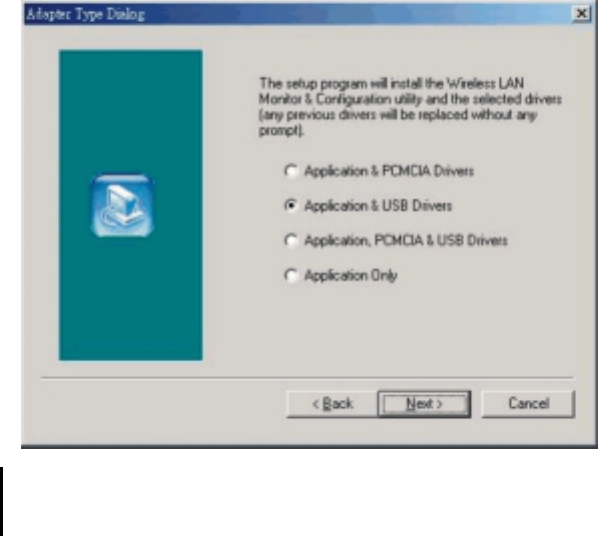
NOTE: If the WLAN USB Dongle driver have been previously installed and have not been
uninstalled prior to this latest installation, the new driver will overwrite the old one without
prompting you.
4. After you have confirmed the driver’s “Destination Location” as well as the
“Program Folders,” choose the mode of operation whether Ad-Hoc or
Infrastructure on the Operating Mode Dialog window.
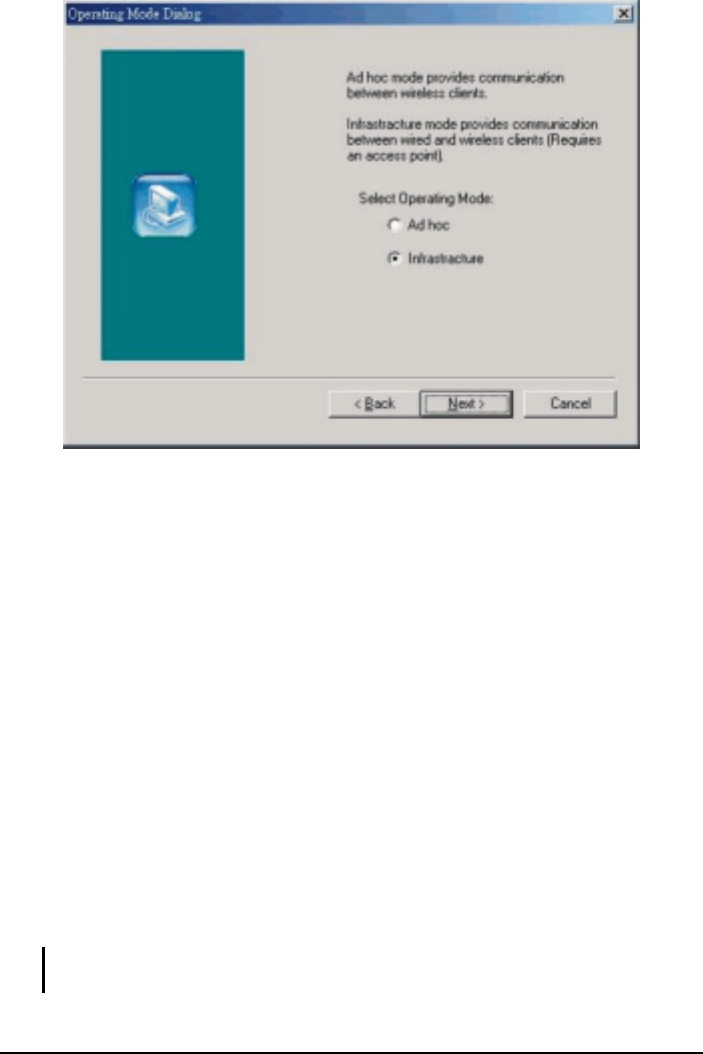
11
Ad-Hoc Mode
In Ad-Hoc mode the wireless stations can communicate directly with
each other.
When selecting the Ad-Hoc mode you need to specify the ESSID and
the Channel parameters.
– ESSID: All stations participating in the Ad-Hoc network should
have the same ESSID.
– Channel: Select the 14 channels available for use.
Infrastructure Mode
In Infrastructure mode the use of an Access Point (AP) is necessary for
wireless stations to communicate with each other.
When selecting the Infrastructure mode you need to specify the
ESSID.
– ESSID: Specify the ESSID of the AP to which the wireless station
will be associated with.
NOTE: You can still change the Operating Mode afterwards using the Configuration &
Monitor Application utility.

5. After you have made your selection, click Next and a window listing your
installation setting appears. If the settings are correct, click Next to
continue. In case you made a mistake, click Back to make the correction and
follow the onscreen instructions to exit the installation.
NOTE: For Windows 2000, select Yes when the “Digital Signature Not Found” window
appears.
6. Re-boot your system after completing the installation.
NOTE: To uninstall the driver and utility, refer to the section “Uninstalling the Driver and
Utility” on the Appendix.
7. Upon re-booting your system, the Configuration & Monitor Application
utility icon should appear on your Window’s system tray.
For Linux
Module Parameters
In order to reconfigure the WLAN USB Dongle, use one of the applications that
comes with the driver:
fvnet (command line utility) or
xvnet (graphical interface for the X windows)
For more information on using the fvnet and xvnet applications, refer to the
relevant Linux system manual pages (man xvnet or man fvnet).
NOTE: If nothing happens the first time you plug in your WLAN USB Dongle,
then run # insmod vnetusba.
2.3 Connecting the WLAN USB Dongle
NOTE: Make sure that the WLAN USB Dongle’s driver as well as the Configuration &
Monitor Application utility has been properly installed (see previous section).
Connect one end of the included USB cord to the WLAN USB Dongle’s USB
port and the other end to the USB port of your computer.
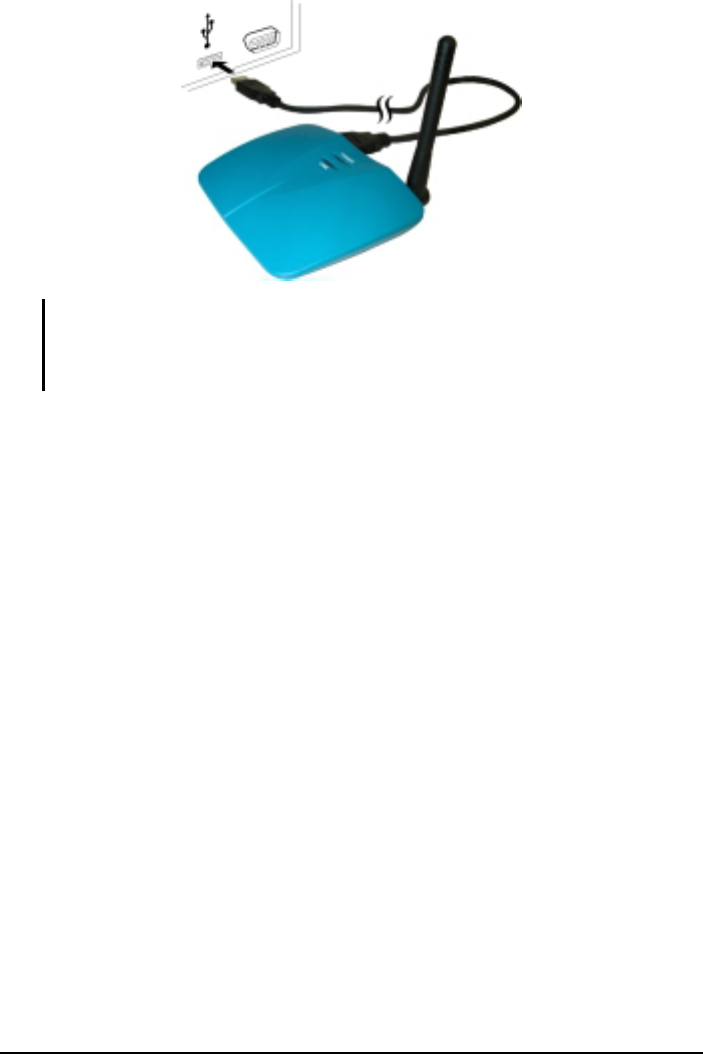
13
NOTE: If you have never installed the driver of the USB port of your system, then Windows
would automatically detect the new hardware and may prompt you to install it. Have the
Windows installation CD ready (in case you are prompted for it) and follow the onscreen
instructions to install the driver.
Your WLAN USB Dongle should start searching for wireless signals from an
AP (Infrastructure mode) or another wireless station (Ad-Hoc mode).
2.4 Site Selection
The following are the tested typical outdoor operating range:
250 M at 11 Mbps (high speed)
350 M at 5.5 Mbps (medium speed)
400 M at 2 Mbps (standard speed)
500 M at 1 Mbps (low speed)
The range of the wireless signal is related to the Transmit Rate of the wireless
communication (Tx Rate on the Monitor utility of the Configuration &
Monitor Application utility). Communications at lower transmit range may
travel larger distances.

NOTE: The range values listed above are typical distances measured. These values may
provide a rule of thumb and may vary according to the actual radio conditions at the
location where the WLAN USB Dongle will be installed.
The range of your wireless devices can be affected when the antennas are placed near
metal surfaces and solid high-density materials.
Range is also impacted due to “obstacles” in the signal path of the radio that may either
absorb or reflect the radio signal.
If you intend to use the WLAN USB Dongle as part of an outdoor antenna
installation, the range of the outdoor antenna installation will be related to
clearance of the radio signal path.
The typical conditions when used indoors in “office environments” can be
described as follows:
In Open Office environments, antennas can “see” each other, i.e., there are
no physical obstructions between them. This describes the ideal indoor
antenna installation.
In Semi-open Office environments, workspace is divided by shoulder-
height, hollow wall elements; antenna are at desktop level. This describes
the typical indoor antenna installation.
In Closed Office environments, workspace is separated by floor-to-floor
ceiling brick walls. This type of indoor antenna installation is not applicable
to your WLAN USB Dongle.

15
3 Using the Configuration &
Monitor Application Utility
3.1 Getting Started
In special circumstances, you may need to change configuration settings
depending on how you would like to manage your wireless network. The
Configuration & Monitor Application utility enables you to make configuration
changes and perform user-level diagnostics on your WLAN USB Dongle as
well as monitor the status of communication.
To use the Configuration & Monitor Application utility:
1. Make sure that the Configuration & Monitor Application utility has been
installed properly (see Chapter 2).
2. The Configuration & Monitor Application utility appears as an icon on the
Windows’ system tray. Double-click on this icon.
NOTES:
When the station is in Infrastructure mode and not associated with an AP, color of the
icon is red.
When the station is in Infrastructure mode and associated with an AP, color of icon is
blue.
When the station is in Ad-Hoc mode, color of icon is always blue.
When the station is in Ad-Hoc mode and the WLAN USB Dongle is resetting and
initializing, color of icon is red.
3. When the Configuration & Monitor Application utility appears onscreen,
make sure that “USB Dongle” is selected on the very top of the window.
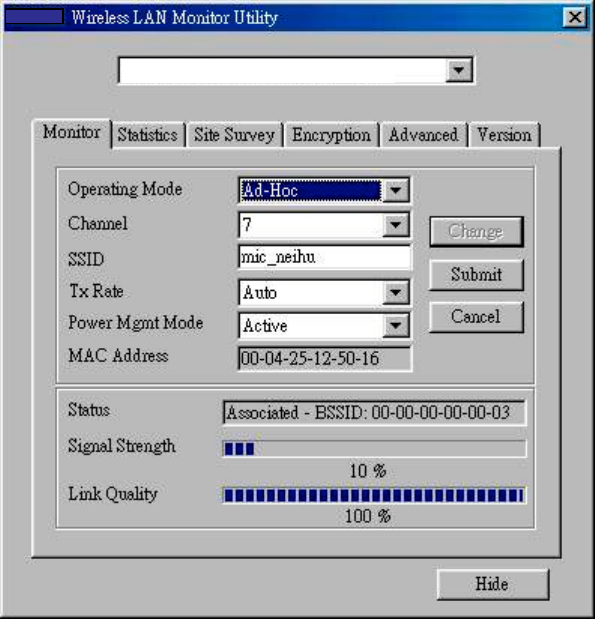
3.2 Monitor
The following configuration parameters are shown:
Operating Mode
Allows you to choose between Ad-Hoc or Infrastructure mode. In Ad-Hoc
mode the wireless stations can communicate directly with each other. In
Infrastructure mode the use of an Access Point (AP) is necessary for
wireless stations to communicate with each other.
Channel
This item is available only if Ad-Hoc mode was selected in the previous
field. Select the 14 channels available for use.

17
SSID
When using the wireless station in an Ad-Hoc mode then all participating
stations should have the same SSID. When using the wireless station in an
Infrastructure mode the SSID must be the same as the SSID of the AP it is
associated with.
TxRate
Your WLAN USB Dongle provides various transmission (data) rate options
for you to select. In most networking scenarios, the option Auto will prove
the most efficient. This setting allows your WLAN USB Dongle to operate
at the maximum transmission rate. When the communication quality drops
below a certain level, the WLAN USB Dongle will automatically switch to
a lower transmission rate. Transmission at lower data speeds are usually
more reliable. However, when the communication quality improves again,
the WLAN USB Dongle will gradually increase the transmission rate again
until it reaches the highest available transmission rate. If you wish to
balance speed versus reliability, you can select any of the available options.
Power Mgmt Mode
Allows you to minimize power consumption and conserve the battery life of
your computer.
MAC Address
On a Local Area Network (LAN) or other network, the MAC (Media
Access Control) address is your computer’s unique hardware number. On
an Ethernet LAN, it is the same as your Ethernet address.
The communication status is also shown:
BSSID
Basic Service Set IDentifier of the AP to which the WLAN USB Dongle is
associated.
Signal Strength
Signal level when receiving the last responding packet. Signal strength is
calculated as the percentage of its signal level measurement relative to the
full signal level.
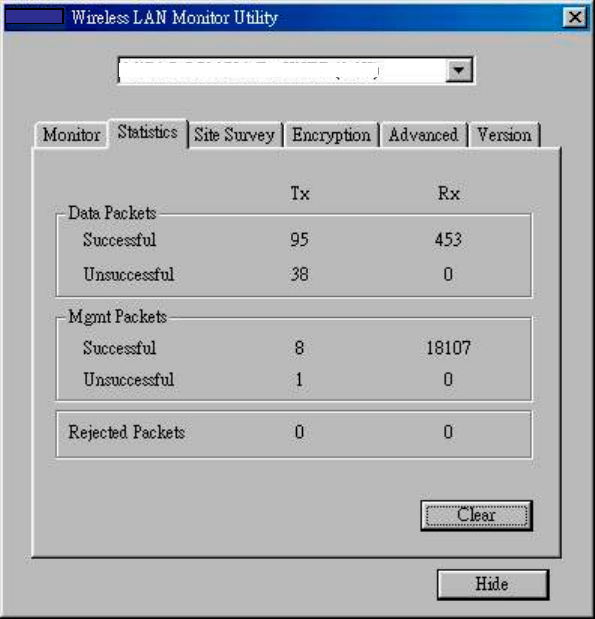
Link Quality
Shows the point-to-point data transmission quality between your WLAN
USB Dongle and another WLAN station (Ad-Hoc mode) or the
transmission quality between your WLAN USB Dongle and the AP it is
associated with (Infrastructure mode).
To change the configuration parameters press Change, make your changes then
click Submit to save your changes.
3.3 Statistics
The Statistics utility allows you to view the statistic (Packets) information
(Data Packets, Mgmt Packets, and Rejected Packets). To renew or update the
list of statistics, press Clear.
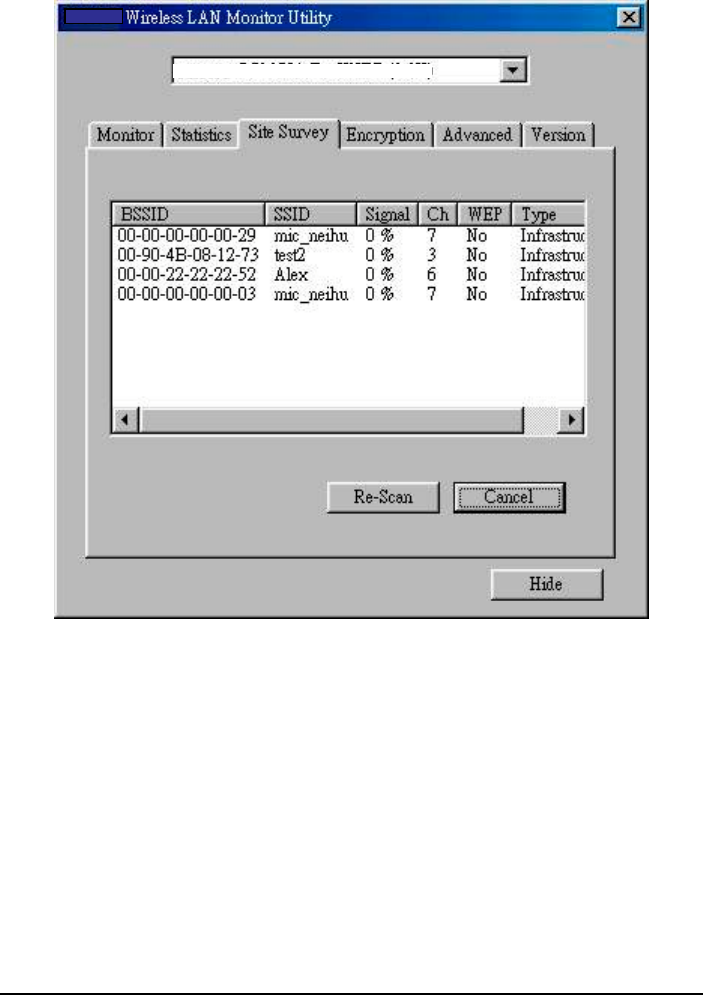
19
3.4 Site Survey
The Site Survey utility allows you to scan all the channels to locate all the APs
(Access Points) within range of your WLAN USB Dongle. When an/various
AP(s) are located, information regarding the BSSID and SSID, signal strength
and channel where the AP operates, whether or not WEP encryption is used, and
the operating mode is shown. Click Re-Scan to update the list.
To associate with any of the APs listed, double-click on your choice (on the
BSSID field) and the utility will take you back to the Monitor utility showing
you the parameters of the newly established connection.
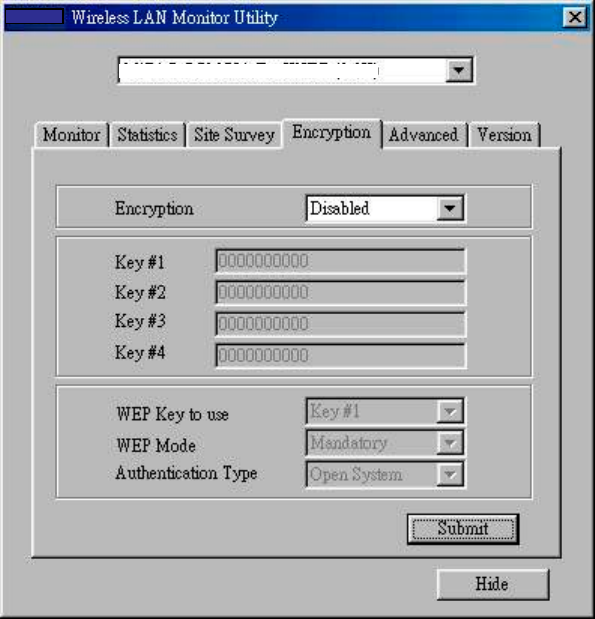
3.5 Encryption
To prevent unauthorized wireless stations from accessing data transmitted over
the network, the Encryption utility offers highly secure data encryption by
allowing you to set four different WEP keys and specify which one to use. To
set encryption:
1. Choose Enabled on the Encryption window.
2. Select any of the available WEP keys (Key #1 to #4) on the WEP Key to
use window. The WEP keys must be in HEX (hexadecimal) format in the
range of a to f, A to F, and 0 to 9.
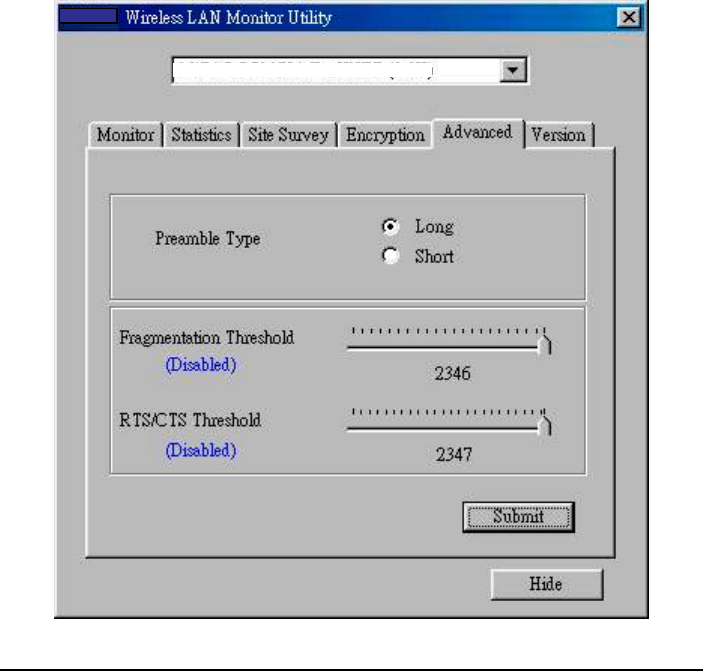
21
3. Select the WEP Mode (Mandatory or Optional).
If Mandatory is selected, then not only must you use WEP encryption
but also any other station you are communicating with must also use
WEP encryption for a link to be established. This requirement is part of
the IEEE 802.11b standard.
If Optional is selected, then your station can communicate with every
other station regardless if they use WEP encryption or not.
4. Select the Authentication Type (Open System or Shared Key).
5. Press Submit for any changes to take effect.
3.6 Advanced
The Advanced utility allows you to change the following advanced
configuration settings:
Preamble Type
Before selecting Short, make sure that the other station(s) and AP supports
this feature. The WLAN USB Dongle has an auto-detect feature that allows
it to select the Preamble Type depending on the Preamble Type of the AP
it is associated with.
Fragmentation Threshold
Allows you to set the Fragmentation Threshold (threshold for the activation
of the fragmentation mechanism). The Fragmentation function is used for
improving the efficiency when high traffic flows along in the wireless
network. If you often transmit large files in the wireless network, move the
slide bar with your mouse and then use the right and left arrow keyboard
keys to select an exact number. The figure shows the recommended
configuration setting.
RTS/CTS Threshold
Allows you to set the RTS Threshold (threshold for the activation of the
RTS/CTS mechanism). Transmitter contending for the medium may not
hear each other. RTS/CTS (Request-To-Send/Clear-To-Send) mechanism
can solve this “Hidden Node Problem.” If the packet size is smaller than the
preset RTS Threshold size, the RTS/CTS mechanism will not be enabled.
To enable RTS/CTS Threshold, move the slide bar with your mouse and
then use the right and left arrow keyboard keys to select an exact number.
The figure shows the recommended configuration setting.

23
4 Troubleshooting
This chapter covers potential problems you may run into and the possible
remedies. After each problem description, some instructions are provided to
help you to diagnose and solve the problem.
4.1 Preliminary Checklist
Here are helpful hints to follow before you take further actions when you
encounter problems:
Try to isolate which part of the computer’s network connection is causing
the problem.
Make sure that the cable connections are correct and secure (from WLAN
USB Dongle’s USB port to the computer’s USB port).
Absence of, or conflict of the WLAN USB Dongle driver. Make sure that all
device drivers are correctly installed (refer to chapter 2).
If a problem persists after you follow the instructions in this chapter, contact an
authorized dealer for help.
4.2 Installation Problem
Problems encountered during installation.
Reconnect one end of the USB cable to the WLAN USB Dongle and the
other end to the computer again. The Power LED indicator on the WLAN
USB Dongle should be ON (red) if the USB cable is properly connected.
Check if the I/O and IRQ for the WLAN USB Dongle have conflict
problems with other devices connected to your computer.
For Windows 98 / 2000 / Me / XP operating system, make sure that the USB
device driver is installed on your computer.
4.3 Configuration Problem
Problems encountered with the configuration.
Use the Monitor utility of your Configuration & Monitor Application
utility to check the Link Quality of your WLAN USB Dongle with the AP it
is associated with (Infrastructure mode) or with other wireless station(s)
(Ad-Hoc mode).
Use the Site Survey utility of your Configuration & Monitor Application
utility to check if there is high interference around the environment.
4.4 Access Point Problem (Infrastructure Mode)
Problems with settings for the Access Point.
Make sure that the Access Point that your WLAN USB Dongle is associated
with is powered on and all the LEDs are working properly.
Reconfigure and reset the Access Point.
Use the Web Manager / Telnet of the Access Point to check whether it is
connected to the network.
4.5 Communication Problem
The WLAN USB Dongle cannot communicate with the computer in the
Ethernet when Infrastructure mode is configured.
Make sure that the Access Point your WLAN USB Dongle is associated
with is powered on.
Use the Site Survey utility of the Configuration & Monitor Application
utility to verify if the operating radio channel is in good quality. Or, change
the Access Point and all the wireless station(s) within the BSSID to another
radio channel.

25
Out-of-range situation, which prevents the WLAN USB Dongle from
establishing a wireless connection with the network. Move the WLAN USB
Dongle closer to the Access Point it is associated with.
Make sure that your WLAN USB Dongle is configured with the same
security option (encryption) to the Access Point.
Make sure that the BSSID is the same as the Access Point for a roaming-
disabled wireless station, or the ESSID is the same as the Access Point for a
roaming-enabled wireless station.
4.6 LAN Problem
I cannot access the network.
Make sure that the necessary driver(s) is correctly installed.
Make sure that the network configuration is appropriate.
Make sure that the user name or password is correct.
You have moved out of range of the network.
Turn off power management.
4.7 Software Problem
The Configuration & Monitor Application utility does not work correctly.
Make sure that the Configuration & Monitor Application utility is
correctly installed (refer to chapter 2).
If you are sure the operation has stop, reset the computer.

27
A Appendix
A.1 Specifications
NOTE: Specifications are subject to change without notice.
Parts Specifications
Frequency Band ISM Band
2400 to 2483.5 MHz (for USA and Canada)
2400 to 2483.5 MHz (for Europe)
2400 to 2497 MHz (for Japan)
Operating Channel IEEE 802.11b, Direct Sequence Spread Spectrum (DSSS)
11 Channels (for USA and Canada)
13 Channels (for Europe)
14 Channels (for Japan)
Modulation Technique BPSK (low transmit rate) / QPSK (standard transmit rate) /
CCK (high and medium transmit rate)
Data Rate Up to 11 Mbit/s
Antenna Single
Antenna Gain 1 dBi maximum
Radiation Power 16 dBm typical
Receiver Sensitivity –80 dBm at 11 Mbps
–82 dBm at 5.5 Mbps
–87 dBm at 2 Mbps
–90 dBm at 1 Mbps
Power Consumption 5 V, 320 mA TX, 230 mA RX
Dimension (W×H×D) 84×20×92 mm
Weight 48 g
Environment
Temperature Operating: 0°C (32°F) to 55°C (131°F)
Storage: –20°C (–3.91°F) to 70°C (158.02°F)
Environment Humidity Operating: 0% to 70%
Storage: 0% to 95% (non-condensing)

Parts Specifications
Regulation (compliant) Wi-Fi compliant, FCC/CA, CE (Europe), DGT/BSMI
OS Support Windows 98 / Me / 2000 / XP / Linux 2.2.x
A.2 Uninstalling the Utility and Driver
Configuration & Monitor Application Utility
1. Exit the Configuration & Monitor Application utility if it is currently active.
2. Select the “Uninstall Configuration & Monitor Application” option by
clicking on Start, then Programs, then 802.11 Wireless LAN.
NOTE: If during the uninstall process you receive an error message, insert the driver CD
and try to uninstall again.
WLAN USB Dongle
For Windows 98 / Me / XP –
1. Select the “Network” icon by clicking on Start, then Settings, then Control
Panel.
2. Select the “WLAN USB Dongle” from the list and click on Remove.
3. When the system prompts you to re-boot, select “Yes.”
For Windows 2000 –
1. Make sure that the WLAN USB Dongle is plugged into the USB port.
2. Select the WLAN USB Dongle under Device Manager.
3. Click on Uninstall.

29
G lossary
802.11 The IEEE standard that specifies WLAN MAC and PHY (Physical
Layer) specifications.
802.11b The IEEE standard that specifies Higher-Speed Physical Layer
Extension in the 2.4 GHz band for 5.5 and 11 Mbps WLANs.
802.3 The IEEE standard that specifies carrier sense media access control and
physical layer specifications for Ethernet LANs.
Access Control The prevention of unauthorized usage of network resources by
demanding that users supply a login name and password.
Access Point
(AP) Any entity that has station functionality and provides access to the
distribution services, via the Wireless Medium (WM) for associated
stations.
Ad-Hoc An Ad-Hoc WLAN is a group of computers each with wireless adapters
connected as an independent WLAN.
Authentication In a multi-user or network operating system, the process by which the
system validates a user's logon information. A user's name and password
are compared against an authorized list, and if the system detects a
match, access is granted to the extent specified in the permission list for
that user.
Authenticity Proof that the information came from the person or location that
reportedly sent it. One example of authenticating software is through
digital signatures.
Bandwidth A frequency measurement, expressed in cycles per second (hertz) or bits
per second (bps), of the amount of information that can flow through a
channel. The higher the frequency, the higher the bandwidth.
Base Station In mobile telecommunications, a base station is the central radio
transmitter/receiver that maintains communication with the mobile radio
telephone sets within its range. In cellular and personal communications
applications, each cell or micro-cell has its own base station, each base
station in turn is interconnected with other cell’s base stations.
Bit (Binary Digit) – A single digit number in base-2, in other words, either a
one or a zero. The smallest unit of computerized data.
Broadband Of or relating to communications systems in which the medium of
transmission (such as a wire or fiber-optic cable) carries multiple
messages at a time, each message modulated on its own carrier frequency
by means of modems. Broadband communication is found in wide area
networks.
BSS Basic Service Set. An AP associated with several wireless stations.
Byte Abbreviated B. Short for binary term. A unit of data, today almost
always consisting of 8 bits. A byte can represent a single character, such
as a letter, a digit, or a punctuation mark. Because a byte represents only
a small amount of information, amounts of computer memory and
storage are usually given in kilobytes (1,024 bytes), megabytes
(1,048,576 bytes), or gigabytes (1,073,741,824 bytes).
Cryptoanalysis The act of analyzing (or breaking into) secure documents or systems that
are protected with encryption.
Decryption The act of restoring an encrypted file to its original state.
Directional
Antenna An antenna that concentrates transmission power into a direction thereby
increasing coverage distance at the expense of coverage angle.
Directional antenna types include yagi, patch and parabolic dish.
Direct Sequence
Spread Spectrum Abbreviated DSSS. A type of spread spectrum radio transmission that
spreads its signal continuously over a wide frequency band.
EMI ElectroMagnetic Interference. The interference by electromagnetic
signals that can cause reduced data integrity and increased error rates on
transmission channels.
Encryption The act of substituting numbers and characters in a file so that the file is
unreadable until it is decrypted. Encryption is usually done using a
mathematical formula that determines how the file is decrypted.
ESSID (Extended Service Set IDentification) The ESSID identifies the Service
Set the station is to connect to. Wireless clients associating to the AP
must have the same ESSID.
Ethernet A very common method of networking computers in a LAN. There are a
number of adaptations to the IEEE 802.3 Ethernet standard, including
adaptations with data rates of 10 Mbits/sec and 100 Mbits/sec over
coaxial cable, twisted-pair cable and fiber-optic cable. The latest version
of Ethernet, Gigabit Ethernet, has a data rate of 1 Gbit/sec.
Gateway A device that connects networks using different communications
protocols so that information can be passed from one to the other. A
gateway both transfers information and converts it to a form compatible
with the protocols used by the receiving network.
Gigahertz (GHz) One billion cycles per second. A unit of measure for frequency.
Hertz (Hz) The unit of frequency measurement; one cycle (of a periodic event such
as a waveform) per second. Frequencies of interest in computers and
electronic devices are often measured in kilohertz (kHz = 1,000 Hz = 103
Hz), megahertz (MHz = 1,000 kHz = 106 Hz), gigahertz (GHz = 1,000
MHz = 109 Hz), or terahertz (THz = 1,000 GHz = 1012 Hz).

31
Host Any computer on a network that is a repository for services available to
other computers on the network. It is quite common to have one host
machine provide several services, such as WWW and USENET.
HTTP Acronym for HyperText Transfer Protocol. The client/server protocol
used to access information on the World Wide Web.
IEEE 802
Standards A set of standards developed by the IEEE to define methods of access
and control on LANs. The IEEE 802 standards correspond to the
physical and data-link layers of the ISO Open Systems Interconnection
model, but they divide the data-link layer into two sublayers. The logical
link control (LLC) sublayer applies to all IEEE 802 standards and covers
station-to-station connections, generation of message frames, and error
control. The MAC sublayer, dealing with network access and collision
detection, differs from one IEEE 802 standard to another: IEEE 802.3 is
used for bus networks that use CSMA/CD, both broadband and
baseband, and the baseband version is based on the Ethernet standard.
IEEE 802.4 is used for bus networks that use token passing, and IEEE
802.5 is used for ring networks that use token passing (token ring
networks). In addition, IEEE 802.6 is an emerging standard for
metropolitan area networks, which transmit data, voice, and video over
distances of more than five kilometers.
internet (Lower case I) Any time you connect two or more networks together,
you have an internet.
Internet (Upper case I) The worldwide collection of networks and gateways that
use the TCP/IP suite of protocols to communicate with one another. At
the heart of the Internet is a backbone of high-speed data communication
lines between major nodes or host computers, consisting of thousands of
commercial, government, educational, and other computer systems, that
route data and messages. One or more Internet nodes can go off line
without endangering the Internet as a whole or causing communications
on the Internet to stop, because no single computer or network controls it.
Currently, the Internet offers a range of services to users, such as FTP,
email, the World Wide Web, Usenet news, Gopher, IRC, telnet, and
others. Also called Net.
Intranet A private network inside a company or organization that uses the same
kinds of software that you would find on the public Internet, but that is
only for internal use.
ISP (Internet
Service
Providers)
ISPs provide connections into the Internet for home users and
businesses. There are local, regional, national and global ISPs. You can
think of local ISPs as the gatekeepers into the Internet.
LAN (Local Area
Network) Personal and other computers within a limited area that are linked by
high-performance cables so that users can exchange information, share
peripherals, and draw on programs and data stored in a dedicated
computer called a file server.
Ranging tremendously in size and complexity, LANs may link only a
few personal computers to an expensive, shared peripheral, such as laser
printer. More complex systems use central computers (file servers) and
allow users to communicate with each other via electronic mail to share
multi-user programs and to access shared databases.
Linux A version of the UNIX System V Release 3.0 kernel developed for PCs
with 80386 and higher-level microprocessors. Linux is distributed free
with source code through BBSs and the Internet, although some
companies distribute it as part of a commercial package with Linux-
compatible utilities. The Linux kernel works with the GNU utilities.
MAC (Media
Access Control) On a LAN or other network, the MAC address is your computer’s unique
hardware number. (On an Ethernet LAN, it is the same as your Ethernet
address.) The MAC layer frames data for transmission over the network,
then passes the frame to the physical layer interface where it is
transmitted as a stream of bits.
Megahertz (MHz) A measure of frequency equivalent to 1 million cycles per second.
Modulation The conversion of a digital signal to its analog equivalent, especially for
the purposes of transmitting signals using telephone lines and modems.
Network Any time you connect two or more computers together so that they can
share resources, you have a computer network. Connect two or more
networks together and you have an internet.
NIC (Network
Interface Card) A board that provides network communication capabilities to and from a
computer system. Also called an adapter.
Node In LAN, a connection point that can create, receive, or repeat a message.
Nodes include repeaters, file servers, and shared peripherals. In common
usage, however, the term node is synonymous with workstation.
Packet A basic message unit for communication across a network. A packet
usually includes routing information, data and (sometimes) error detection
information.
PCMCIA
(Personal
Computer
Memory Card
International
Association)
Develops standards for PC Cards, formerly known as PCMCIA Cards.
They are available in three types that are about the same length and width
as credit cards but range in thickness from 3.3 mm (Type I) to 5.0 mm
(Type II) to 10.5 mm (Type III). These cards provide many functions,
including memory storage and acting as landline modems and as WLAN.
POP (Post Office
Protocol) This is a common protocol used for sending, receiving and delivering mail
messages.

33
Port (H/W) An interface on a computer for connecting peripherals or devices to the
computer. A printer port, for example, is an interface that is designed to
have a printer connected to it. Ports can be defined by specific hardware
(such as a keyboard port) or through software.
Port An Internet port refers to a number that is part of a URL, appearing after a
colon (:) right after the domain name. Every service on an Internet server
listens on a particular port number on that server. Most services have
standard port numbers, e.g., web servers normally listen on port 80.
Privacy The concept that a user's data, such as stored files and email, is not to be
examined by anyone else without that user's permission. A right to privacy
is not generally recognized on the Internet. Federal law protects only
email in transit or in temporary storage, and only against access by Federal
agencies. Employers often claim a right to inspect any data on their
systems. To obtain privacy, the user must take active measures such as
encryption.
Protocol A “language” for communicating on a network. Protocols are sets of
standards or rules used to define, format and transmit data across a
network. There are many different protocols used on networks. For
example, most web pages are transmitted using the HTTP protocol.
Proxy Server A server that performs network operations in lieu of other systems on the
network. Proxy servers are most often used as part of a firewall to mask
the identity of users inside a corporate network yet still provide access to
the Internet. When a user connects to a proxy server via a web browser or
other networked application, he submits commands to the proxy server.
The server then submits those same commands to the Internet, yet without
revealing any information about the system that originally requested the
information. Proxy servers are an ideal way to also have all users on a
corporate network channel through one point for all external
communications. Proxy servers can be configured to block certain kinds
of connections and stop some hacks.
Public Key
Encryption An asymmetric scheme that uses a pair of keys for encryption: the public
key encrypts data, and a corresponding secret key decrypts it. For digital
signatures, the process is reversed: the sender uses the secret key to create
a unique electronic number that can be read by anyone possessing the
corresponding public key, which verifies that the message is truly from the
sender.
Radio Frequency
(RF) The portion of the electromagnetic spectrum with frequencies between 3
kilohertz and 300 gigahertz. This corresponds to wavelengths between 30
kilometers and 0.3 millimeter.
Range A linear measure of the distance that a transmitter can send a signal.
RFC (Request for
Comments) An RFC is an Internet formal document or standard that is the result of
committee drafting and subsequent review by interested parties. Some
RFCs are informational in nature. Of those that are intended to become
Internet standards, the final version of the RFC becomes the standard and
no further comments or changes are permitted. Change can occur,
however, through subsequent RFCs.
Roaming A function that enables one to travel with his mobile end system (e.g.,
WLAN mobile station) throughout a domain (e.g., an ESS) while being
continuously connected to the infrastructure.
Router An intermediary device on a communications network that expedites
message delivery. On a single network linking many computers through a
mesh of possible connections, a router receives transmitted messages and
forwards them to their correct destinations over the most efficient
available route. On an interconnected set of LANs using the same
communications protocols, a router serves the somewhat different
function of acting as a link between LANs, enabling messages to be sent
from one to another.
RTS (Request-
To-Send)
Threshold
A signal sent, as from a computer to its modem, to request permission to
transmit. Transmitter contending for the medium may not hear each other.
RTS/CTS mechanism can solve this “Hidden Node Problem.” If the
packet size is smaller than the preset RTS Threshold size, the RTS/CTS
mechanism will not be enabled.
Server 1. On a LAN, a computer running administrative software that controls
access to the network and its resources, such as printers and disk drives,
and provides resources to computers functioning as workstations on the
network.
2. On the Internet or other network, a computer or program that responds
to commands from a client. For example, a file server may contain an
archive of data or program files; when a client submits a request for a file,
the server transfers a copy of the file to the client.
SSL (Secure
Sockets Layer) Technology that allows you to send information that only the server can
read. SSL allows servers and browsers to encrypt data as they
communicate with each other. This makes it very difficult for third parties
to understand the communications.
Station (STA) Any device that contains an IEEE 802.11 conformant Medium Access
Control (MAC) and physical layer (PHY) interface to the Wireless
Medium (WM).
Telnet An Internet protocol that enables Internet users to log on to another
computer linked to the Internet, including those that cannot directly
communicate with the Internet’s TCP/IP protocols. Telnet establishes a
“plain vanilla” computer terminal called a network virtual terminal. This
capability is frequently used to enable communications with bulletin
board systems (BBSs) and mainframe computers. For example, you will
often see hyperlinks to Telnet sessions while browsing the WWW. If you
click such a hyperlink, your browser starts a Telnet helper program, and
you see a text-only command window. In this window, you type
commands and see the remote system’s responses.

35
URL (Uniform
Resource
Locator)
An address for a resource on the Internet. URLs are used by Web browsers
to locate Internet resources. A URL specifies the protocol to be used in
accessing the resource (such as http: for a World Wide Web page or ftp:
for an FTP site), the name of the server on which the resource resides
(such as //www.whitehouse.gov), and, optionally, the path to a resource
(such as an HTML document or a file on that server).
VPN (Virtual
Private Network) 1. A set of nodes on a public network such as the Internet that
communicate among themselves using encryption technology so that their
messages are as safe from being intercepted and understood by
unauthorized users as if the nodes were connected by private lines.
2. A WAN formed of permanent virtual circuits (PVCs) on another
network, especially a network using technologies such as ATM or frame
relay.
WAN (Wide Area
Network) A network that uses high-speed, long-distance communications networks
or satellites to connect computers over distances greater than those
traversed by LANs – about 2 miles (3.22 km).
Wired Equivalent
Privacy (WEP) The optional cryptographic confidentiality algorithm specified by IEEE
802.11 used to provide data confidentiality that is subjectively equivalent
to the confidentiality of a wired LAN medium that does not employ
cryptographic techniques to enhance privacy.
Wireless Local
Area Network
(WLAN)
A flexible data communications system implemented as an extension to,
or an alternative for a wired LAN. Using radio frequency (RF)
technology, WLANs transmit and receive data over the air, minimizing
the need for wired connections.
Wireless Medium
(WM) The medium used to implement the transfer of protocol data units (PDUs)
between peer physical layer (PHY) entities of a WLAN.
WWW (World
Wide Web) The total set of interlinked hypertext documents residing on HTTP servers
all around the world. Documents on the World Wide Web, called pages or
Web pages, are written in HTML (Hypertext Markup Language),
identified by URLs (Uniform Resource Locators) that specify the
particular machine and pathname by which a file can be accessed, and
transmitted from node to node to the end user under HTTP (Hypertext
Transfer Protocol). Codes, called tags, embedded in an HTML document
associate particular words and images in the document with URLs so that
a user can access another file, which may be halfway around the world, at
the press of a key or the click of a mouse. These files may contain text (in
a variety of fonts and styles), graphics images, movie files, and sounds as
well as Java applets, ActiveX controls, or other small embedded software
programs that execute when the user activates them by clicking on a link.
A user visiting a Web page also may be able to download files from an
FTP site and send messages to other users via email by using links on the
Web page. Also called w3, W3, Web.